Device Management
The Device Management section allows to manage the devices connected to the Zerynth Industrial IoT & AI Platform, the firmwares installed and the claimed SIM Cards.
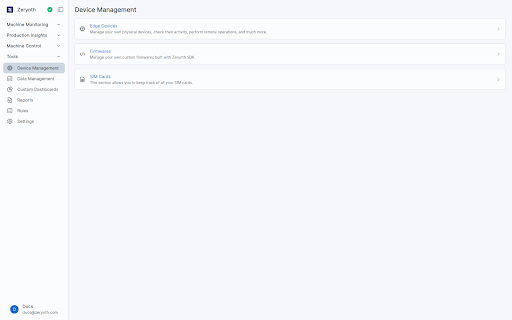
Edge Devices
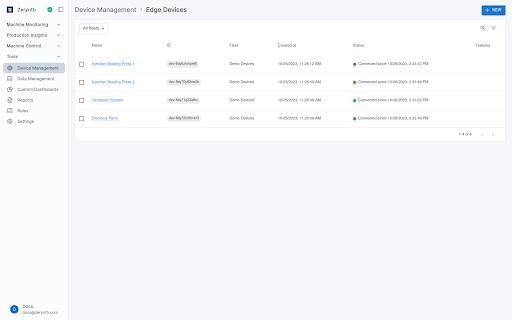
The Edge Devices page shows the list of devices linked to the current Workspace of the Zerynth Industrial IoT & AI Platform.
For each device, the table shows the following information:
- Name: the name of the device;
- ID: the unique identifier of the device;
- Fleet: the fleet the device belongs to;
- Created at: the date and time of the device creation (expressed in local time);
- Status: the connection status of the device;
- Features: eventual additional features of the device (such as the claim of a physical device or a SIM Card).
The table can be sorted by any of the columns, and the sorting order can be reversed by clicking again on the same column.
The table has a search function, that allows to search for a device by name, ID, fleet or creation date, and a filter function, that allows to filter the devices by connection status.
Read more about the filter functions in the Knowledge base.
Device details
Clicking on a device name in the table opens the Device details page. Every device has multiple tabs at the top of the page, which allow to access different information and data about the device.
Overview
This page shows an overview of the device, with some basic informations about connection, hardware and latest activity.
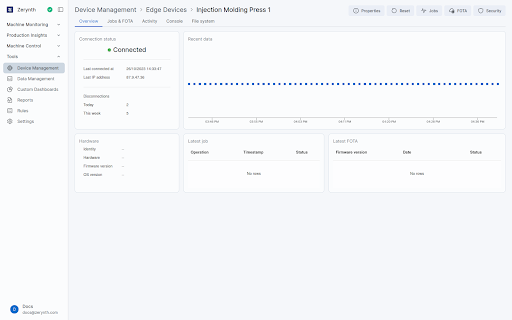
This page is divided in multiple cards, which show the following columns:
- Connection status: the connection status of the device, with the last connection and its relative IP address, other than the amount of disconnections in the last 24 hours and in the last week;
- Recent data: a graph showing dots for every message sent by the device in the last hour;
- Hardware: the serial number of the device, with its device type (if associated to a physical device), the firmware version and the Zerynth OS version
- Latest job: the latest job sent to the device, with its status and the date and time of the job request;
- Last FOTA: the last FOTA sent to the device, with its status and the date and time of the FOTA request.
Properties
The Properties button opens a modal which shows the properties of the device.
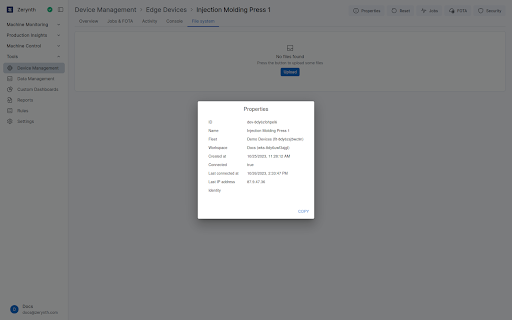
Reset
The Reset button opens a modal which allows to reset the device, in case it's misbehaving or not responding normally.
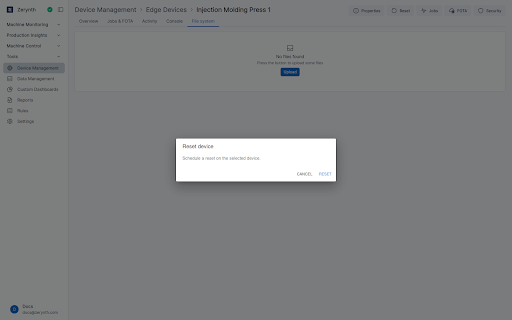
Caution! Resetting a device won't work if the device is not connected to the Cloud.
Jobs & FOTA
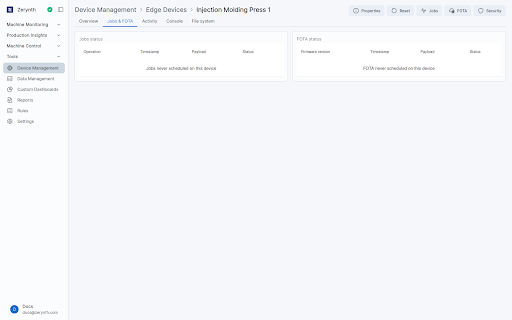
This page shows the history of jobs and FOTA sent to the device, with two main cards showing the following columns:
- Jobs status: the name of the job, with the timestamp of the job request, its payload and the status of the job, which can be Pending, Done or Failed;
- FOTA status: the name of the FOTA, with the timestamp of the FOTA request, its payload and the status of the FOTA, which can be Pending, Done or Failed.
A new Job can be scheduled using the Jobs button at the top of the page, which opens a modal with the following fields:
- Operation: the name of the job, a list sent by the device upon connection;
- Args: the arguments of the job, in JSON format. If the job doesn't require any argument, this field needs an empty JSON object ().
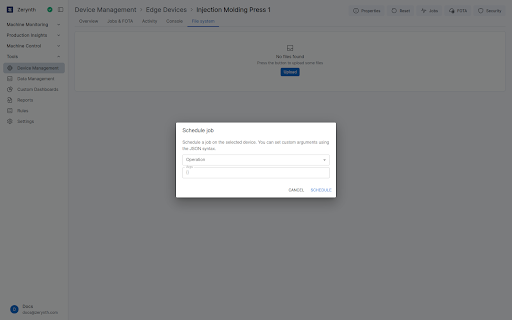
A new FOTA can be scheduled using the FOTA button at the top of the page, which opens a modal with the following fields:
- Firmware: the firmware to be installed on the device, a list of firmwares uploaded to the current workspace;
- Version: the version of the firmware to be installed on the device.
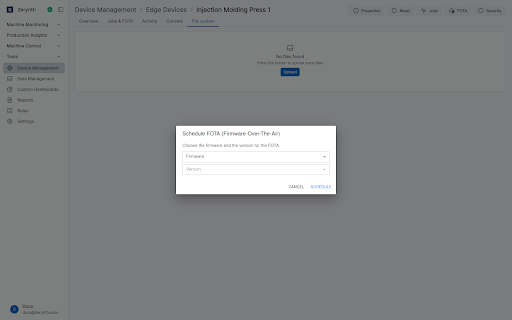
Caution! Jobs and FOTAs won't work if the device is not connected to the Cloud.
Activity
This page shows the activity of the device, meaning every event sent by the device or received by the device from the Cloud.
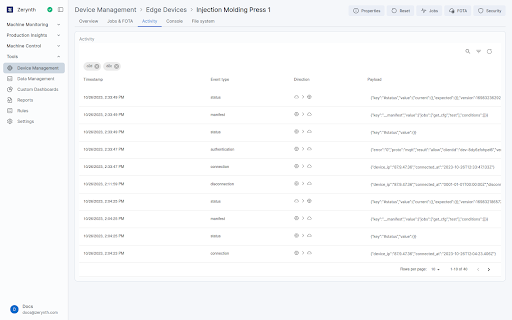
The activity is shown with a table showing the following columns:
- Timestamp: the timestamp of the activity;
- Event type: the type of the event which occured;
- Direction: the direction of the event, which can be Cloud to Device or Device to Cloud;
- Payload: the payload of the event.
This table can be sorted by any of the columns, and the sorting order can be reversed by clicking again on the same column.
It can also be filtered by event timestamp, type and direction. Read more about the filter functions in the Knowledge base.
Console
This page shows a live console of the messages sent by the device.
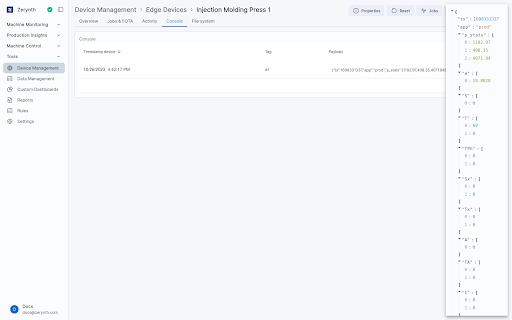
The console is displayed as a table, containing the timestamp of the message, the tag and the payload.
This table can be sorted by any of the columns, and the sorting order can be reversed by clicking again on the same
column.
File system
This page shows the file system of the device, with a view of the uploaded files.
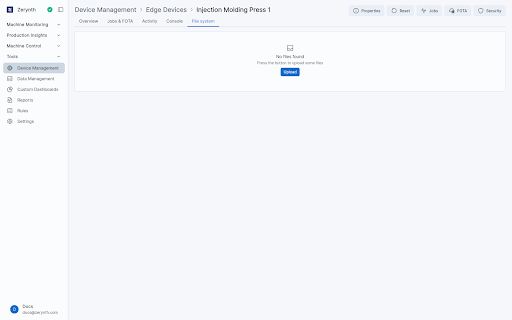
If no files are present in the device file system, a message is shown instead, along with the possibility to upload some files instead.
Security
The Security button at the top of the page opens a modal to download a new identity for the device. This way the device can be re-registered to the Cloud with a new identity. The previous identity will then be revoked.
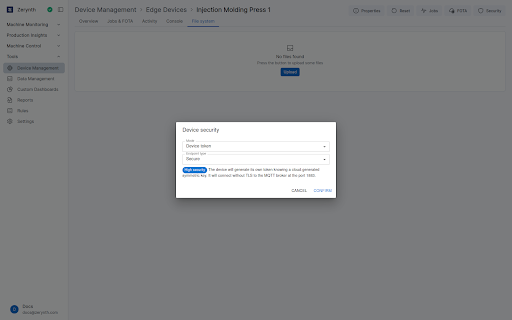
This modal asks the following information:
- Mode: the mode of the identity, which can be Device token (default) or Cloud token. A Device token identity uses a token generated by the device knowing a cloud key, while a Cloud token identity uses a token generated by the Cloud;
- Endpoint type: the endpoint type of the identity, which can be Secure or Insecure. A Secure identity uses a secure endpoint (port 8883), while an Insecure identity uses an insecure endpoint (port 1883).
Firmwares
The Firmwares page shows the list of firmwares uploaded to the current Workspace of the Zerynth Industrial IoT & AI Platform.
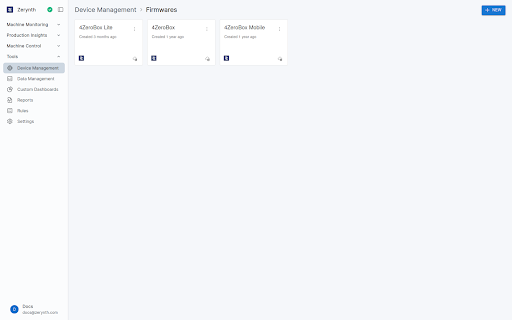
For each firmware, there is a card showing the following information:
- Name: the name of the firmware;
- ID: the unique identifier of the firmware;
- Creation date: the date of the firmware creation;
- Version: the version of the firmware;
- Owner: the owner of the firmware.
For each firmware, there is a Schedule FOTA button, which allows the user to schedule a FOTA for a single device or an entire fleet.
The user also has a + New button in the topright corner of the page, which allows to upload a new firmware with a custom name chosen by the user.
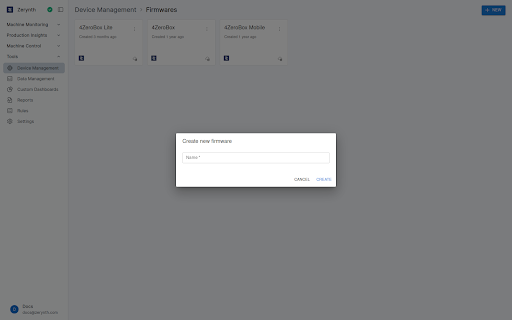
SIM Cards
The SIM Cards page shows the list of SIM Cards linked to the current Workspace of the Zerynth Industrial IoT & AI Platform.
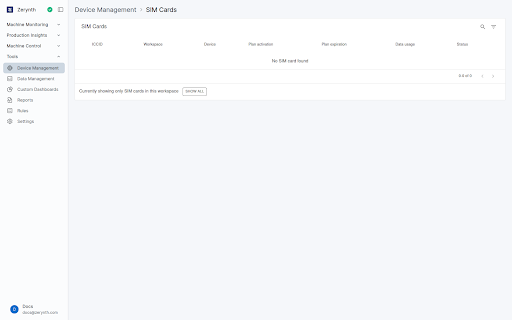
For each SIM Card, the table shows the following columns:
- ICCID: the ICCID of the SIM Card;
- Workspace: the Workspace the SIM Card belongs to;
- Device: the device the SIM Card is linked to;
- Plan activation: the date of the plan activation;
- Plan expiration: the date of the plan expiration;
- Data usage: the amount of data used by the SIM Card;
- Status: the status of the SIM Card, which can be Active, Suspended or Expired.
At the bottom of the table, there is a button that allows to change the view, which can be grouped by Workspace or by account.